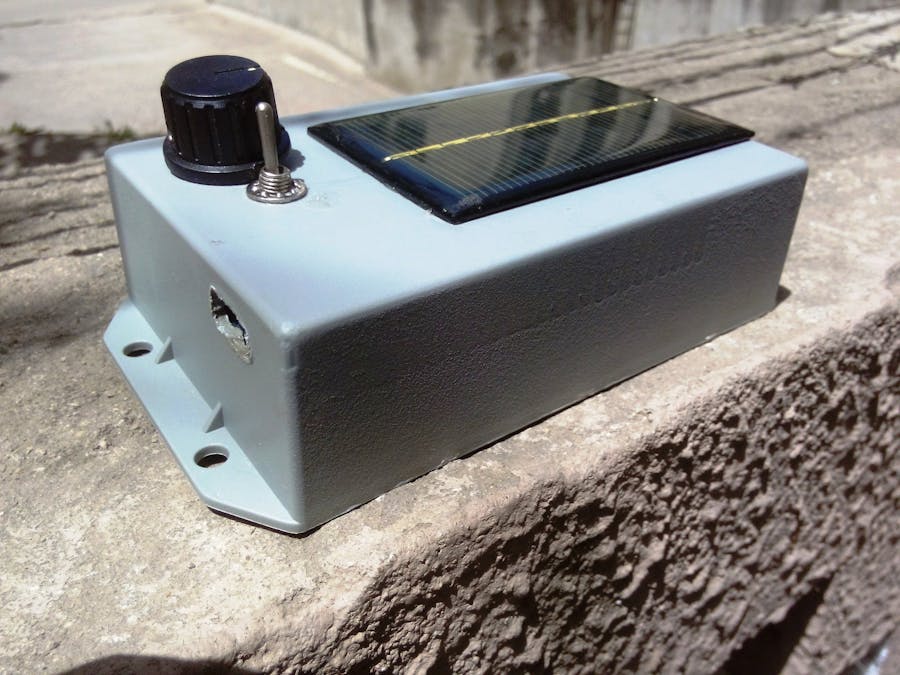Please sign up for pre launch Indiegogo campaign: https://www.indiegogo.com/projects/tame-the-beast-solar-power-station-for-arduino/coming_soon
Short SummaryThis solar powering unit is a time switching battery powered solar charged circuit, used to power an Arduino Uno and some peripherals. The solar powering unit presented here is energy efficient. When we talk about Arduino, it consumes lots of energy in displays and other work that are not important. The solar powering unit presented here has a timer which turns on the Arduino in regular intervals. When you have a project like weather station, remote data logger, etc. or applications like this, you do not have to keep your Arduino on all the time. And of course in all this applications, powering is the major issue. If you turn on the Arduino in 1 minute or any interval, it can save a lot energy. This unit is variable i.e. you can decide the time delay! The unit can also power your Arduino when there is no sunlight(at night) as it has a rechargeable battery inside.
It's not just a solar powering, it has a timer. It's a two in one combination of solar energy and timer.
The unit consists of two solar panels, one is for the timer circuit and another is for output. The timer circuit is connected to relay module. The unit also consists of rechargeable cells which are charged by solar panel. When you want to use power from them, you need to just toggle the switch.
Features:- Time switching device
- Variable i.e. you can change the time delay
- Can also work without sunlight!
- Easy to use
- Switch for using power from batteries
- Highly compatible with Arduino and its peripherals
- Long battery life
- Detachable solar panel
- Portable
- Clean energy
The unit actually contains a timer which is variable and the time delay can be adjusted by Potentiometer. The maximum time delay you can set is 5 minutes. The minimum time delay is 30 seconds. If there is no proper sunlight, a switch is provided to run your Arduino on Batteries! The port for this is different.
Applications:Weather StationsThis unit can be used to power weather monitors. Here it is not necessary to keep the sensors working 24/7. They can be made working using specific time delay which can save a lot power.
Data logggersThe unit can also be used to power data loggers. They can collect data at specific time delays saving energy.
Powering copper pipe theft alarmCopper pipe theft is increasing day by day increasing demand of copper. For prevention of this, copper pipe theft alarms are placed in industries.
"There's no question the theft has gotten much, much worse," said Mike Adelizzi, president of the American Supply Association, a nonprofit group representing distributors and suppliers in the plumbing, heating, cooling and industrial pipe industries.
This unit can be used to power the alarm system. In daytime we can use timer mode as the chances are lower for theft at daytime. For night time, special switch is placed in unit which keeps Arduino awake all the time. Thus, saving energy at daytime and using it at night.
Leakage detectionThe unit can be used to power leakage detector circuit. This will check the leakage every specific time interval thus, saving energy.
In industries:The timers are necessary to time the tasking and production which then enables to calculate costs and other elements.
But here, it's not just a timer it is power saving timer which powers your equipment.
Battery Life Calculation:- Arduino ON time: 1 seconds
- Arduino OFF time: 1 min. = 60 seconds
- Power(when ON) = 1/3600 x 3mA = 0.0042 mWh
- Power(when OFF)= 1/60 x 0.2mA = 0.167mWh
- Operating Voltage: 5V
- Power(ON+OFF): 0.17mWh
- Li-Ion Battery: 2100mAh
- Battery Voltage: 2.4V
- Power: 2100 x 2.4 = 5040mWh
- Battery Life: 5040/0.17 = 30k cycles
Note: Power consumed by power booster is not calculated here.
Thus, timer circuit saves a lot energy and also saves energy by cutting power of sensors, displays, etc. In sleep mode, the power consumed by ATMEL micro controller will reduce.
Without timer mode:An Arduino Uno runs less than one day on a 9 V battery because it uses about 45 mA current.
Source: http://www.home-automation-community.com
We want to raise fund to start the production of this solar powering units. Please share it as much as possible!
Thanks!




_ztBMuBhMHo.jpg?auto=compress%2Cformat&w=48&h=48&fit=fill&bg=ffffff)








_3u05Tpwasz.png?auto=compress%2Cformat&w=40&h=40&fit=fillmax&bg=fff&dpr=2)


Comments
Please log in or sign up to comment.